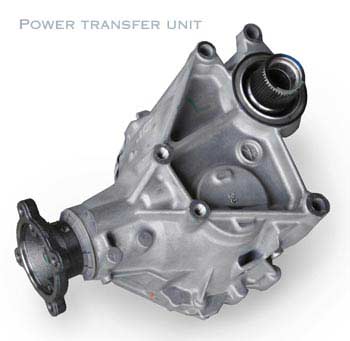When should the transfer case oil be changed?
Updated: March 17, 2020
The transfer case is an important part of the vehicle's all-wheel drive or four-wheel drive system, but it's often the most neglected component. In pickup trucks and truck-based SUVs, the transfer case is a large mechanism attached to the rear end of the transmission. It may contain a center differential, low-range gearing and other controls of the 4WD system. The transfer case distributes the torque between the front and rear axles.
Both drive (propeller) shafts transferring power to the front and rear axles are connected to the transfer case (see the photo).Many compact and mid-size all-wheel drive crossovers and car-based SUVs have a smaller transfer case (see photo below) that is called a power transfer unit. A power transfer unit is attached to the transaxle (transmission) and provides the power output for the rear drive shaft. The rear drive shaft transfers the power from the power transfer unit to the rear axle; see the AWD diagram. Regardless of the size, a transfer case or unit is filled with and lubricated by a special fluid or gear oil.
For the 2017 F150 pickup truck, Ford recommends changing the transfer case fluid every 150,000 miles for normal driving conditions and every 60,000 miles when towing a trailer, operating in dusty or sandy conditions or off-roading.
What if you only do normal city/highway driving and the maintenance schedule doesn't mention transfer case fluid change for normal conditions? Can a transfer case last the lifetime of the vehicle without changing the fluid? The simple answer is no. Any mechanical device with moving or rotating parts wears out. The products of wear mix with oil, and this causes gears and other internal components to wear faster. In many cars, a transfer case is located close to hot exhaust components; the heat also causes the fluid to deteriorate sooner. See this photo of the inside of a failed power transfer unit at 105,000 miles.
In our opinion, even for normal driving conditions, the transfer case fluid should be changed at least every 60,000-70,000 miles or sooner if so recommended in the maintenance schedule. The fluid should also be changed if the transfer case has been submerged in water. Your mechanic can check the fluid condition first and change it if it's dirty.
The transfer case or unit usually has two plugs: a fill plug above and a drain plug below. The fluid level and condition can be checked through the fill plug.
In most vehicles, a transfer case is filled with a small amount of gear oil (usually SAE 75W-85, 80W-90 or 75W-140 grade). The transfer case of the Toyota FJ Cruiser in the photo, for example, takes only 1.5 quarts (1.4 liters) of SAE 75W gear oil.
Advertisement
The transfer case should also be checked regularly for leaks. Leaks should be repaired as soon as possible. The first sign of a leak is a gear oil (sulfur) smell coming from under the vehicle and oil drops on the driveway.
Is it easy to change the transfer case fluid at home? In most trucks, it's not very difficult, but you might need an oil pump to pump the gear oil into the transfer case. In crossovers and car-based SUVs, access is more difficult, as the power transfer unit is located behind the engine, close to the exhaust.





